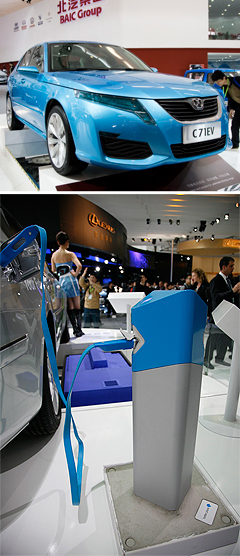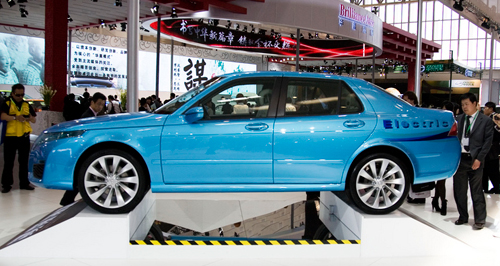News - General NewsElectrify or perishPower house: Chinese car-maker Beijing Automotive Import and Export Corporation (BAIC) unveiled this electric version of its C71 at the Beijing motor show. Better Place urges EV solution to local manufacturers to extend large-car future27 Apr 2010 By BYRON MATHIOUDAKIS in TOKYO BETTER Place CEO Shai Agassi has warned Australia’s manufacturers to implement their plans now to build electric vehicles if they hope to survive against EV imports from Asia and Europe. Speaking at the opening of the world’s first battery switch site for electric taxis in Japan, the founder of the electric vehicle infrastructure pioneer said Better Place’s global network rollout from next year was timed to coincide with the imminent arrival of commercially viable EVs such as the Nissan Leaf. “If you wait three years you’re going to be importing (EVs) from China – and you won’t have a car industry in Australia,” he said told GoAuto. Now operational, the Tokyo battery switch site will be the first of tens of thousands that will progressively be rolled out around the world – with Australia set for a late 2011 introduction, in readiness for the EV influx. Besides Nissan, other manufacturers such as Renault and now China’s Chery are expected to import EVs into Australia soon. Last weekend on th sidelines of the Beijing motor show, Chery signed a memorandum of understanding to develop a switchable battery EV prototype with Better Place, taking 10 per cent ownership stake in Better Place. Research by HSBC bank indicates China is poised to grow its share of the global EV market from today’s 2.7 per cent to about 35 per cent by 2020. However, while Better Place Australia CEO Evan Thornley agrees cheap imported EVs look set to make their mark in Australia, he says the remaining three manufacturers now have a unique opportunity to take the initiative and reinvigorate their large-car programs by considering EV electric vehicle applications. But it will not be open for long, he added.  Left: BAIC's C71 EV concept at Beijing motor show. BELOW: A Better Place charging station on Chery's stand at Beijing. Left: BAIC's C71 EV concept at Beijing motor show. BELOW: A Better Place charging station on Chery's stand at Beijing.While refusing to disclose which Australian car-maker is in discussion with Better Place, Mr Thornley revealed on-going dialogue, particularly as the Japanese taxi battery switch station will be a showcase for all car-makers around the world, as well as consumers and Better Place sceptics, to see, feel and touch the EV infrastructure in action. Better Place, in conjunction with the Japanese Economy, Trade and Industry Ministry and Tokyo’s largest taxi operator, Nihon Kotsu, will run four converted-to-EV Nissan Dualis over the next three month to demonstrate to the public the battery switch operation in a real-world application with nearly continuous operation. Mr Thornley said that – as the converted Dualis example proves – even the architecture of existing Australian-built cars such as the Holden Commodore, Ford Falcon, Ford Territory and Toyota Camry/Aurion twins could be modified relatively easily to accept battery packs. He said he believed this would inject the large-car segment with fresh appeal, particularly to fleet operators in the face of inevitable petrol price rises and increasing calls to cut carbon emissions. As a result, incorporating EV technology into the current generation Commodore or Falcon, for example, has the potential to boost their lifespan. It would also make more financial sense to buyers who – three or five years down the track – could have a better resale value proposition with a vehicle with zero emissions. Further, taking Australia’s considerable knowledge and experience in designing, engineering and building large cars, offering an EV model sooner rather than later might reopen export opportunities for the existing models that adopted an electric architecture, as well as their successors. “We think that there is a particularly attractive opportunity for the Australian manufacturers, just given to the types of cars that we actually make are the types of cars that are going to be most economically attractive,” Mr Thornley said. “I’ve seen an enormous movement in the thinking within the industry in Australia over the last 12 months. We’ve had some very productive discussions and seen a lot of evolution in the (car-makers’) thinking – across the industry. “EVs are becoming a prominent solution and a big potential for our industry. “And (Better Place) is not the only one saying it. If you look at the Auto Innovation Vision Statement that came out last year, the notion of Australia potentially as one of the world’s leading producers of large powerful zero-emissions vehicles is a credible and plausible vision for the Australian industry. “So the Australian industry is particularly well placed to capture that opportunity – and not just domestically, but as an export market. Large cars are – relatively speaking – something of a niche globally market but mainstream in Australia … mainly because fuel consumption is such a big issue in many parts of the world – but once you remove that as a constraint I suspect that there are a lot of people out there who would prefer to drive a larger car than a smaller car. “We’ve got platforms now that fits into an EV relatively quickly, and they can continue to have a large market domestically and potentially large export markets. “As somebody who grew up at the feet of people like (1980s Labor senator and architect of the Australian car industry’s future direction) John Button and others who have always sought a viable future for the Australian car industry. “For me this is one of the most attractive things about the Better Place project – it is something that gives the best chance that I have ever seen in recent times of an exciting future for the Australian industry that is in line with its existing long term direction and public policy – about value-adding it, about having all that high quality engineering and design capacity. “And as a practical matter it is in line with existing vehicle architecture that we have and we know how to build. “And one of the most interesting things about the early transition to EVs for an auto-maker is that it is one opportunity to extend the life of existing platforms. “You’ve got such a differentiated product by putting a new drivetrain into the thing, and if you want to move quickly, you don’t necessarily as your first entry want to go with an entirely new platform. “So there’s quite a nice transition strategy there, as platforms that are very mature are coming to the end of their natural life as an internal combustion platform, you can make an early entry as an EV maker relatively quickly and relatively safely because every other elements of the platform are mature, and you focus the effort then on the powertrain and integration engineering, and then you can relatively quickly come in with a well-known and well proven vehicle. “I think then that this is a very natural progression that is open to a number of Australian car-makers given the current lifecycle of their own platforms. “And the fact that the largest player by far in the charge network infrastructure globally has chosen to do Australia third (behind Israel and Denmark) conveys a particular opportunity for the Australian domestic industry that similar industries elsewhere will not have in their domestic market.”  Read more |
Click to shareGeneral News articlesResearch General News Motor industry news |

















Facebook Twitter Instagram